#MentalFloss.Com
Text
“Eeny, Meeny, Miny, Moe”: The Dark Theories—And Racist History—Behind The Childhood Rhyme
One of The Theories About The Counting-Out Rhyme Involves Human Sacrifice.
— By Lorna Wallace | May 28, 2024

An illustration of the counting-out game “eeny, meeny, miny, moe” from Clara E. Atwood’s ‘A Book of Nursery Rhymes,’ published in 1901. / Wikimedia Commons // Public Domain (illustration); pop_jop/DigitalVision Vectors/Getty Images (Speech Bubble); Justin Dodd/Mental Floss (Background)
common way for kids to decide who’s the undesirable “it” in a game of tag is to use the counting-out rhyme “eeny, meeny, miny, moe” (sometimes spelled “eenie, meenie, miny, moe”). You’ve probably just completed the verse in your head, but if not, here’s a refresher:
“Eeny, meeny, miny, moe,
Catch a tiger by the toe,
If he hollers, let him go,
Eeny, meeny, miny, moe.”
Though the end result is supposedly random, the speaker can manipulate the outcome—for instance, by adding “you are it” at the end. The use of the rhyme has gone beyond the playground and into pop culture: It’s been used by Homer Simpson to prevent a nuclear meltdown and by The Walking Dead’s Negan to decide who in Rick’s group is going to meet a grisly end.
youtube
Different versions of “eeny, meeny, miny, moe” exist around the world, and there seem to be just as many theories about the rhyme’s potential origin—ranging from shepherds counting sheep to priests selecting sacrificial victims.
1. Catching a Tiger by the Toe
2. The Possible Origins of the Rhyme
3. “Eeny Meeny Miny Moe” Around the World
Catching a Tiger by the Toe
In the English-speaking world, the rhyme can be traced back to at least 1815. In an 1855 edition of the scholarly journal Notes and Queries, someone credited only as “W.” recalled the version of the rhyme they used when choosing who was “it” for tag in New York 40 years earlier:
“Hana, mana, mona, mike;
Barcelona, bona, strike;
Hare, ware, frown, venac;
Harrico, warrico, we, wo, wac!”
Although those words don’t match the ones we chant today, the rhythmic flow is the same; “W.” recalled it after reading a version of the rhyme that had been printed earlier that year, one that is slightly more similar to the modern variation:
“Eeny, meeny, moany, mite,
Butter, lather, boney, strike,
Hair, bit, frost, neck,
Harrico, barrico, we, wo, wack.”
In 1888, chemist Henry Carrington Bolton published a study of counting-out rhymes that included German and Dutch jingles, showing that they contained elements of the rhymes cited in America: “Eena, tena, mona mi, / Pastor, lone, bone, strei” and “Eene, meenen, mukken, / Porceleinen stukken,” respectively. But which version came first is unknown. Bolton’s book is also contains what is almost the modern version rhyme, which had the n-word in place of tiger/tigger and was, according to Bolton, “the favourite among American children to-day.”
The following year, Reverend Walter Gregor presented a collection of rhymes (later published in 1891 [PDF]) to the Buchan Field Club in Scotland; he recorded both the n-word version and one which used neighbour. These two Scottish variants used squeals and quarrels, respectively, instead of hollers.
Over the years, the racial slur version of the rhyme has thankfully fallen out of favor, with replacement words including tinker (a derogatory British term for a beggar), piggy, and—today’s most popular choice—tiger.
The Possible Origins of the Rhyme
As is the case with many nursery rhymes, there are a few dark theories about the origin of “eeny, meeny, miny, moe.” One, as explained by author Robert Hendrickson, is that this counting-out rhyme and others, “are relics of formulas Druid priests used to choose human sacrifices.”

Druids (From: Pictures of English History), 1868 / Heritage Images/GettyImages
Another sacrificial starting point was proposed by linguists Jan Naarding and Klaas Heeroma, who argue that an older Dutch version of the song, which begins “anne manne miene mukke,” might come from an Old Saxon divination chant. A high priest would supposedly say the words to prompt a sign from the gods that would indicate who should be sacrificed.
Yet another murderous theory is tied to the Cornish version of the rhyme:
“Ena, mena, mona, mite,
Pasca, lara, bona, (or bora), bi,
Elke, belke, boh,
Eggs, butter, cheese, bread,
Stick, stack, stone dead.”
In an 1880 article for The Cornishman newspaper, Thomas Walter Sandrey suggested that these lines originated in ancient Britain and are about withholding food from someone before they are “beaten to death by sticks.”
A less brutal suggestion is that the words are a corruption of Latin. An unnamed writer in an 1884 issue of Overland Monthly theorized that the jingle was originally a “medieval formula in monkish Latin—probably a charm or prayer used in casting lots.” When non-Latin speakers repeated the chant, the words morphed into gibberish.
There are other theories that stem from the words being misheard between languages. One is that British colonizers in India heard the rhyme “ubi eni mana bou, baji neki baji thou, elim tilim latim gou,” which was sung while playing games. Linguist Derek Bickerton believes that the lyrics stem from the Saõ Tomenese phrase ine mina mana mu, which translates to “my sister’s children” in English. Yet another suggestion is that the verse derives from a Swahili poem that was recited by enslaved people and includes the line “iino ya mmiini maiini mo.”
Linguist John McWhorter thinks that the rhyme comes from a Celtic-language counting system, often known as the Anglo-Cymric Score, which was used by shepherds to count their sheep. Different versions that have been recorded include “yan, tan, tethera, methera, pimp” and “aina, peina, para, pedera, pump” (both of which are one to five). These words definitely have the same rhythmic quality as “eeny, meeny, miny, moe,” but the link isn’t certain. There’s also doubt about the shepherds’ score being ancient—the numbers don’t crop up until the 18th century and might actually derive from Welsh—and even about whether they were ever actually used to count sheep (but there is evidence that they were used by knitters!).
“Eeny Meeny Miny Moe” Around the World
Many languages have similar sounding counting-out rhymes that are partly nonsensical. That may just pure coincidence, but in Bolton’s words, it makes “the view of a common origin reasonable.” Although that origin remains uncertain, here are a few examples from around the globe to compare for yourself:

0 notes
Note
Please share your knowledge of goblin sharks! ❤️
Please share your knowledge of goblin sharks! ❤️
Goblin sharks huh… those with the pointy noses ala probably why they’re called “goblin” sharks… okay, I can do that!
Goblin sharks: the Basics™

[Image source: mentalfloss.com]
Okay so, these weird looking kids drawings brought to life are actually a real rare species of deep-sea shark — that means they live deep out in the ocean, something like 100 metres (330 feet) below in the clear blue. They’re found throughout the world and there’s some researchers out there who argue Goblin Sharks can dive over 1300 metres down (4270 feet) for short pockets of time. That’s almost one-seventh of the height of Mount Everest (29000 feet) by the way. For y’all Americans, your football fields are about 91 metres long, so that means the Goblin Shark can possibly dive 14 football fields.
Not gonna lie, I’m pretty impressed; and slightly scared lol.
Goblin Sharks are the only surviving member of the Mitsukurinidae family of sharks; they have a lineage then of 125 million years and then some! They come from the larger order of Lamniformes which get called Mackerel Sharks and one of its cousins is the Great White.
Heckin’ interesting family reunion I guess; being the only member of that branch of the family still kicking when you see the beefcake great-great-great baby cousin of yours the Great White looking like the Ideal™ Shark. Poor Goblin Shark with his absurd body design and old as balls evolutionary structure.
It hunts cephalopods and crustaceans (squid and crabs or shrimp basically) as well as teleost fish. Teleost fish are, to put it simply, a bony fish that can do like a shark with their jaw and pop them out. Because fish needed to become more terrifying to consider, of course. So the Goblin Shark hunts squid, shrimp, crabs, and fish like fucking Giant Oarfish and the Anglerfish and even Seahorses; depending on where they are in the oceans.
Lovely.
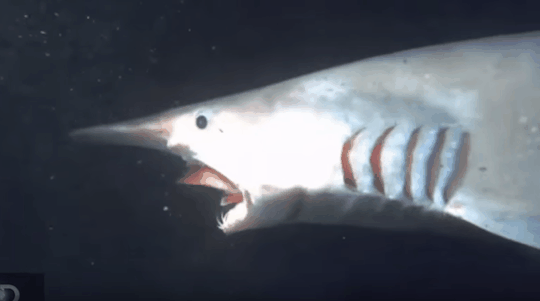
[Image Source: factanimal.com]
Goblin Sharks were “discovered” some time in the 1800s after a description of an immature male was caught in Sagami Bay, Japan and described by David Starr Jordan in 1898, an American ichthyologist who determined that the Goblin Shark caught in Sagami Bay was a new genus and family entirely from other sharks known at the time. Jordan gave the name for the Goblin Shark based on the ship master (Alan Owston) who caught it and the professor at University of Tokyo who assessed it (Kakichi Mitsukuri). Thus, the Goblin Shark’s scientific name is: Mitsukurina owstoni.

[Image source: Wikipedia]
Incidentally, Goblin Shark as a term is a calque (or loan translation borrowed from another language) of its traditional Japanese name tenguzame which is a creature in Japanese mythology with a long nose and red face. Goblin Sharks are also called Elfin Sharks by the way; again, probably due to their facial structure with the nose… idk, that one still confuses me.
Goblin Sharks are considered to be one of the oldest root members of the Lamniformes order; basal meaning base aka near the root/actually the root of a species/order/family etc. Because it’s the last member of a lineage that dates back to the — Middle Eocene (which is around 49 million years ago by the way) for the Goblin Shark as we know it right now — Cretaceous (125 million years ago), the Goblin Shark is called a “living fossil” because it also retains several of the traits “primitive” sharks once had.
Goblin Shark: Description
Goblin Sharks are pink, not the traditionally expected countershading black/grey/blue/some colour and white belly set up other sharks have, and have that long flat snout with very poppy-outty jaws (protrusible, the word is protrusible) with nail-like teeth. Because needle teeth weren’t bad enough obviously. They can grow around 3 to 4 metres, around 13 feet long, but some have been recorded around 6 metres (20 feet).
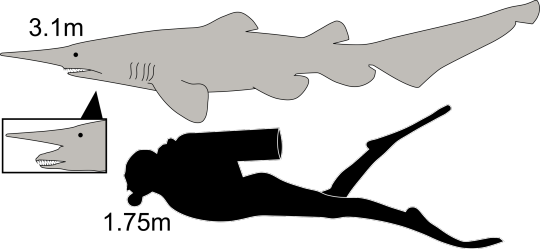
[Image source: Wikipedia]
It also has a flabby old body with small pectoral and dorsal fins which suggest it’s not a fast mover like its cousin the Great White. So this is a pink, blobby thing with stubby fins and a pointy nose that definitely means it ain’t winning any Prettiest Of The Ocean competitions any time soon. Poor fella.

[Image source: Smithsonian Tropical Research Institute]
Goblin Shark snouts are long and flat like a blade (think… which one was it in Pacific Rim with the pointy nose over its face… that’s basically a Goblin Shark head lol), and the snout decreases in length the older they get. They have little eyes with no protective nictitating membrane and behind each eye is a spiracle that leads to the respiratory system of an animal; basically nostrils. Their jaws can extend almost as far as to the end of their snout which is just Not Okay. And with something like 100 rows of teeth in its jaws, you do not want to be bitten by this long nosed nightmare blob from the depths.
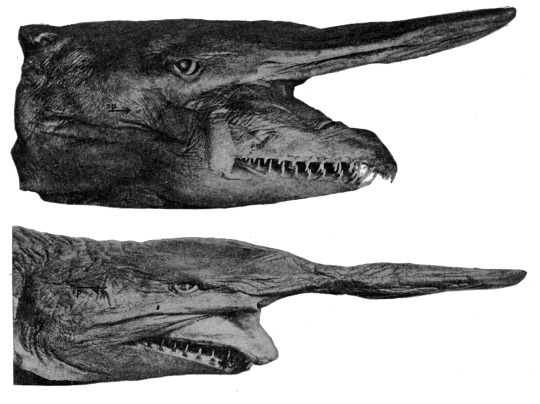
[Image source: Wikipedia]
Goblin Sharks also only have five gill slits which are pretty short to be honest. With a relatively slender, flabby body, and two small dorsal fins that are similar in size and shape, as well as little rounded pectoral fins, Goblin Sharks really don’t scream Effective Fast Predator at all. They’re more ambush predators since they can extend those damned jaws out so damned much. Unlike a lot of other sharks, Goblin Sharks have a rougher skin texture since their dermal denticles are shaped like spines with ridges lengthwise which point upright… charming.
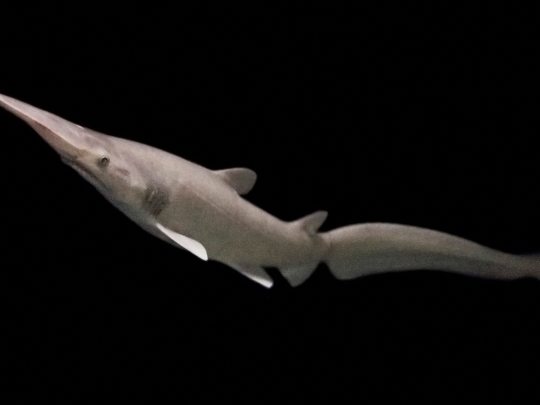
[Image source: National Geographic]
Like other sharks, the Goblin Shark has a field of ampullae of Lorenzini which allow it to sense electric fields in the water that prey produce. This is one of the reasons, by the way, why it can be advised that you punch a shark in the snout when attacked, because that’s where the ampullae of Lorenzini are located. A punch to the snout is essentially a burst of loud as fuck static in your headphones for a shark.
Might get your arm bitten off in the attempt though.
Anyway, digression!
Goblin Sharks: Where to find em
You’ll find these nightmare nail teeth monstrosities in all the major oceans from the Atlantic where its been found in the Gulf of Mexico, southern Brazil, France, Portugal, and Senegal (to name a few), to the Indo-Pacific and Oceanic where it’s been found in the waters off South Africa, Japan, New Zealand, and Australia. So yeah… basically everywhere. Great!

[Image source: Wikipedia]
Just something extra
So back when the Goblin Shark was being discovered and information about it getting published in journals etc, in 1910, a researcher wrote about the Goblin Shark and, honestly, bit harsh man… bit harsh. The wrote:
“...the new shark is certainly grotesque… the most remarkable feature is the curiously elongated nose…” — Hussakof, L, 1910, The Newly Discovered Goblin Shark of Japan. Scientific American: A Division of Nature.
So there ya go! Stuff about Goblin Sharks! Now I’m going to go be thankful I don’t swim in the ocean for the next ten hours while rocking in a corner :D
122 notes
·
View notes
Text

Attendance Prompt 10/23:
“Ancient Egyptians wrapped mummies in linens dyed with hematite [here]; Osiris, god of the afterlife and underworld, was also known as the “lord of the red cloth."(pg 139)
I did not know the ancient Egyptians wrapped mummies in red linen. I assumed all of the mummies were wrapped in gold, to send wealth to the afterlife- at least that is what I thought. I have heard of Osiris, the god of the afterlife and underworld, but I did not know Osiris was also referred to as the lord of the red cloth.
Butterflies:
Butterflies steal and use poison to deter predators. (mentalfloss.com)
Some butterflies can grow up to a foot long. (mentalfloss.com)
Butterflies can live from one week to nine months- depending on butterfly type, but the average lifespan for a butterfly is one month. (mentalfloss.com)
Butterflies are not able to fly if their body temperature is less than 86 degrees Fahrenheit. (Petpedia.co)
Butterflies do not sleep, they become inactive to rest but do not sleep. (Petpedia.co)
Images:
Instax mini camera: The camera encourages mistakes, unlike other cameras where the photographer is advised to adjust the settings. (bhphotovideo.com)
Slinky: “Since its introduction, more than 250 million Slinkys have been sold, enough for every person in the United States to have one. Stretched out, the wire would encircle the planet more than 126 times." (kids.kiddle.co)
Barbie: The doll was not invented as a toy for kids. It was marketed as a racy gag gift for men in tobacco shops. (History.com)
Lego flower arrangement: The word lego is a mixture of two Danish words, “Leg” and “Godt” which translate to “play well”. (factretriever.com)
Mr. Potato Head: The toy was the first ever toy to be in an advertisement on television. (screenrant.com)
2 notes
·
View notes
Text
khanacademy.org
freerice.com
fuckinghomepage.com
artofmanliness.com
unplugthetv.com
coursera.org
lizardpoint.com
ted.com
lifehacker.com
lifehackninja.com
good.is/inforgraphics
mathrun.net
justinguitar.com
duolingo.com
memrise.com
cookingforengineers.com
thedatingspecialist.com
zenhabits.net
nerdfitness.com
mentalfloss.com
openculture.com
charitynavigator.org
lettersofnote.com
thedailymiscellany.com
0 notes
Text
Basic Definition
Used mainly in biological contexts, the word zygopleural describes things that are bilaterally symmetrical—or in other words, the left and right sides are reflected, like a butterfly.
40 Zesty Z-Words To Add To Your Vocabulary (mentalfloss.com)


https://paoloviscardi.com/tag/identification/
0 notes
Text

The Highest-Rated Book in Each Country, Mapped
If you want to add more diversity to your reading list, check out the map below. It features the top-rated books by local authors in more than 130 countries, according to Goodreads users.
mentalfloss.com/posts/highest-…
0 notes
Video
vimeo
Flowers from Thomas Blanchard on Vimeo.
My first flowers timelapse has finished. 4 months and 9624 shots 5K RAW (259 GO).
'FLOWERS' participate in the biennial internationale of contemporary art of Casablanca 2016
EXHIBITION:
Colysee Lambersart Lille, for Azuma Makoto 東信
SYDNEY CHILDREN'S HOSPITAL ART PROGRAM
-------------------------------------------------------------------------
Music : Linda Scott - Three guesses
itunes.apple.com/fr/album/complete-hits-linda-scott/id549532649
en.wikipedia.org/wiki/Linda_Scott
-------------------------------------------------------------------------
Here is the list of flowers that have been part of the video.
Pink wedding flowers: 353 pics, interval 11 minutes
Pink : 248 pics, interval 13 minutes
Purple Lilies : 246 pics, interval 8 minutes
White Amaryllis : 343 pics, interval 8 minutes
Red Lilie : 353 pics, interval 8 minutes
White Amaryllis : 305 pics, interval 6 minutes
Pink Lilie : 649 pics, interval 10 minutes
White Hyacinth : 332 pics, interval 8 minutes
Red Amaryllis : 340 pics, interval 9 minutes
Whites Amaryllis : 370 pics, interval 8 minutes
Orange Lilies : 342 pics, interval 10 minutes
Alstroemeria : 555 pics, interval 10 minutes
Blue Iris : 346 pics, interval 8 minutes
Daffodils : 417 pics, interval 5 minutes
Freesia : 612 pics, interval 10 minutes
White Lilies : 503 pics, interval 10 minutes
Pink Hyacinth : 636 pics, interval 7 minutes
Red Amaryllis : 259 pics, interval 8 minutes
White Lilie : 249 pics, interval 10 minutes
Tulips : 1379 pics, interval 5minutes
Amaryllis (Nymph) : 787 pics, interval 8 minutes
I created this video simply because I love nature. I always found the flower's timelapses fabulous, but most of the time they are made with a black background. Then I told myself to make a beautiful flower's timelapse with coloured and vintage backgrounds. To me, the 60's / 70's is the most representative period for the flowers. This is a way to pay tribute to them.
Thanks: Maud Regnault
-------------------------------------------------------------------------
My web site : thomas-blanchard.com
Facebook : facebook.com/thomasblanchardgraphiste
------------------------------------------------------------------------
-HUFFINGTONPOST-
huffingtonpost.com/2015/03/18/flowers-blooming-time-lapse_n_6895644.html?1426705272
-KOREUS-
koreus.com/video/flowers-timelapse-fleurs.html
-PETAPIXEL-
petapixel.com/2015/03/14/this-time-lapse-captures-the-beauty-of-21-kinds-of-flowers-blooming/
-NATIONAL GEOGRAPHIC-
nationalgeographic.it/multimedia/2015/04/15/news/timelapse_fiori_piante-2566650/
-MOTHER NATURE NETWORK-
mnn.com/earth-matters/wilderness-resources/blogs/watch-21-flowers-bloom-in-2-minutes
-THE CREATORS PROJECT-
thecreatorsproject.vice.com/blog/flowers-bloom-in-5k-in-stunning-new-timelapse
-SOO CURIOUS-
soocurious.com/fr/timelapse-fleur-video-nature-artiste/
-MENTALFLOSS-
mentalfloss.com/article/62257/exquisite-video-shows-high-def-time-lapse-flowers-blooming
-LAUGHINGSQUID-
laughingsquid.com/gorgeous-high-definition-time-lapses-of-flowers-blooming/
-FUBIZ-
fubiz.net/2015/03/12/blossoming-flowers-timelapse/
-SPLOID-
sploid.gizmodo.com/staring-straight-into-the-center-of-a-blooming-flower-i-1691210729
-TWISTED SIFTER-
twistedsifter.com/videos/5k-timelapse-shows-21-flowers-in-bloom/
-DISTRACTIFY-
distractify.com/mark-pygas/flower-timelapse/
-SPOTLIGHT MEDIA-
spotlight-media.jp/article/143190349191242280
-FASTCODESIGN-
fastcodesign.com/3043747/get-excited-for-spring-with-this-flower-strip-tease
-PIXABLE-
pixable.com/article/get-mood-spring-gorgeous-blooming-flowers-time-lapse-video-45457
-DEVOUR-
devour.com/video/flowers/
-TWENTY TWO WOLRDS-
twentytwowords.com/thomas-blanchard-flower-timelapse/
-APLUS-
aplus.com/a/timelapse-flowers-in-bloom
-LAJK-
lajk.hu/2015/03/13/ha-szereted-viragokat-akkor-ez-video-biztosan-tetszeni-fog/
-MOYA PLANETA-
moya-planeta.ru/video/view/cvety_10778/
-LA BOITE VERTE-
laboiteverte.fr/des-fleurs-en-eclosion-rapide/
-BOINGBOING-
boingboing.net/2015/03/16/time-lapses-of-flowers-bloomin.html
-DESIGNFAVES-
designfaves.com/2015/04/watch-flowers-bloom-in-stunning-5k-timelapse-short-film
-BIGGEEKDAD-
biggeekdad.com/2015/03/beautiful-flowers-timelapse/
-DESIGN TAXI-
designtaxi.com/news/373703/Wonderful-Time-Lapse-Video-Of-Flowers-Blooming-Made-With-Almost-10-000-Photos/
-HUMO-
humo.be/actua/326801/timelapse-van-knop-tot-bloem-filmpje
-3NZ-
3nz.it/5974/fiori-timelapse/
-ALL THAT IS INTERESTING-
all-that-is-interesting.com/get-ready-for-spring-with-this-stunning-flowers-time-lapse
-LIFO-
lifo.gr/tv/the-tube/1873
0 notes
Text
http://mentalfloss.com/article/30804/10-amazing-artists-working- miniature-models (add two films where models have been used
well or badly! and discuss why?) you could add Star Wars episode 7 trailer (behind the scenes): Comment on the old stuff and the way the blue screen works.
https://www.youtube.com/watch?v=Z8diJmd0qBg
Resident Evil: Extinction (Vegas Scene) Put the link up and work out why they did it/does it work in the film scene? Would you have known it was a model?
https://www.youtube.com/watch?v=40THZZAgSKQ
https://www.youtube.com/watch?v=qmCEgTSjxWk
Wes Anderson Isle of Dogs animation: Show a couple of sets and describe them https://thespaces.com/inside-the-insane-sets-of-wes-andersons-
To do
0 notes
Text
Why Do So Many Maple Syrup Bottles Have a Tiny Little Handle? It’s Not For Holding, That’s For Sure.
— By Ellen Gutoskey | May 8, 2024

Only a baby could hold this. (Syrup) annick vanderschelden photography/Moment/Getty Images; (Thought bubble) Justin Dodd/Mental Floss
Ideally, you’d be able to hold the handle of a maple syrup container while you carry it and also while you pour the syrup onto pancakes, waffles, or whatever other foodstuff calls for it. But the typical handle on a glass bottle of maple syrup is way too small and positioned too far up the bottleneck to be functional in either respect.
So, why is it there?
What’s a Skeuomorph?
The most widely accepted explanation is that the tiny handle is a skeuomorph, meaning “an ornament or design representing a utensil or implement,” per Merriam-Webster. In other words, a given item has a design element—a skeuomorph—that might help you recognize what the item is or should be used for, but doesn’t necessarily have a purpose beyond that. The floppy disk icon in Microsoft Word is a great example: It’s what you select to save a file, evoking the bygone days of saving files on physical floppy disks. The fact that it looks like a floppy disk clues you in to what the button does (though the clue is likely lost on the kids of today), but the design doesn’t have anything to do with the actual saving capability of said button.
Smart devices are full of skeuomorphs that reflect the physical version of a piece of technology. Your email icon might look like an envelope; your trash folder might make the sound of crumpling paper when you empty it.
But there are plenty of skeuomorphs that don’t involve the transition from analog to digital life, and the useless handle of a maple syrup bottle is one of them.
How Maple Syrup Bottles Got Little Handles

Salt-glazed stoneware predated the United States: This is a German piece from 1602. Heritage Images/GettyImages
Here’s one popular version of the origin story: The little handle harks back to the days of storing liquids in salt-glazed stoneware that often featured handles large enough to actually hold. As maple syrup companies replaced big ceramic jugs with smaller glass ones, they tacked on a little handle as a callback to the former.
However, this story might give you the impression that North Americans had a long history of storing and selling maple syrup in stoneware (with handles)—to the point that people would associate elements of that kind of container specifically with maple syrup. That’s not exactly the case. For one thing, the stoneware was used for various liquids. For another, maple syrup didn’t really catch on as a consumer product until the very late 19th century, when white cane sugar shook off its import tax and started to overtake maple sugar in the market. New England’s maple sugar producers pivoted to making maple syrup, which, according to the Massachusetts Maple Producers Association, they usually sold in “cans and bottles.”

An advertisement from 1921. Library of the University of Toronto, Wikimedia Commons//Public Domain
Maple syrup manufacturers had started to add little handles to their glass bottles by the early 1930s. This, apparently, was a bit of a marketing tactic. “Maple syrup companies weren’t so much retaining an old pattern of a jug as reinventing it and wanting to market their product as something nostalgic,” Canada Museum of History curator Jean-François Lozier told Reader’s Digest Canada. “They were tying in the image of maple syrup with their product and the image that people still had of those crocks in the 19th-century.”
That doesn’t disqualify the tiny handles from being considered skeuomorphs: They’re still a design element meant to evoke a certain thing. But it might be more accurate to say that the original thing was the old-timey quaintness of stone jugs in general rather than maple syrup itself.
0 notes
Text
Snails are packing dozens of rows of pearly whites, with a single snail boasting anywhere between 2000 & 15,000 teeth between its jaws. Up close, the inside of a snail's mouth looks like it's lined with Velcro. The snail teeth hook inward, making it easy for the animal to latch onto its meal & slide it down its gullet.
The sheer number of teeth it has isn't the only thing that makes a snail's smile terrifying. The mollusk cycles through teeth like a shark does, with new rows growing in the back of the mouth & gradually moving forward to bump out the worn teeth up front. Together these rows make something called a radula, a tongue-like pad the snail uses to snag food by extending it out of its mouth, xenomorph-style.
Of all snail varieties, limpets—a small type of sea snail—may be the most dentally gifted: Their teeth are made from protein reinforced by fine mineral nanofibers called goethite, and according to one study, they're even stronger than spider silk, potentially making them the toughest biological material on Earth.
More Info: mentalfloss.com
0 notes
Text
Mammals of Dinosaur Knights
Mammals of Dinosaur Knights
Cat
http://www.animalplanet.com/pets/cats/
http://a-z-animals.com/animals/cat/
http://animals.nationalgeographic.com/animals/mammals/domestic-cat/
http://www.stlcats.org/
http://www.thinkingoutsidethecage.org/site/c.elKWIeOUIhJ6H/b.8540959/k.90CC/Animals_Cats.htm
http://www.thinkingoutsidethecage.org/site/c.elKWIeOUIhJ6H/b.8540959/k.90CC/Ani
mals_Cats.htm
Dog
http://www.animalplanet.com/pets/dogs/
http://www.animalplanet.com/breed-selector/dog-breeds.html
http://a-z-animals.com/animals/dog/
http://animals.nationalgeographic.com/animals/mammals/domestic-dog/
https://www.britannica.com/animal/canine
http://mentalfloss.com/article/30959/14-your-dogs-wild-relatives
Ferret
http://www.worldwildlife.org/species/black-footed-ferret
http://animals.nationalgeographic.com/animals/mammals/black-footed-ferret/
http://www.defenders.org/black-footed-ferret/basic-facts
https://en.wikipedia.org/wiki/Ferret
Goat
https://animalcorner.co.uk/animals/goats/
http://a-z-animals.com/animals/goat/
http://animals.nationalgeographic.com/animals/mammals/mountain-goat/
http://animalplace.org/the-animals-goats/
http://www.onekind.org/education/animals_a_z/goat/
Palfrey (Marchador, Ambler)
https://en.wikipedia.org/wiki/Palfrey
http://www.wwwestra.com/horses/history_medievalbreeds.htm
http://www.scientiareview.org/pdfs/26.pdf
http://www.wisegeek.com/what-is-a-palfrey.htm
0 notes
Text
Who loves Tootsie Roll Pops?
According to mentalfloss.com, it takes licking machines approximately 364 to 411 licks to get to the center of a Tootsie Pop. That owl was wrong!
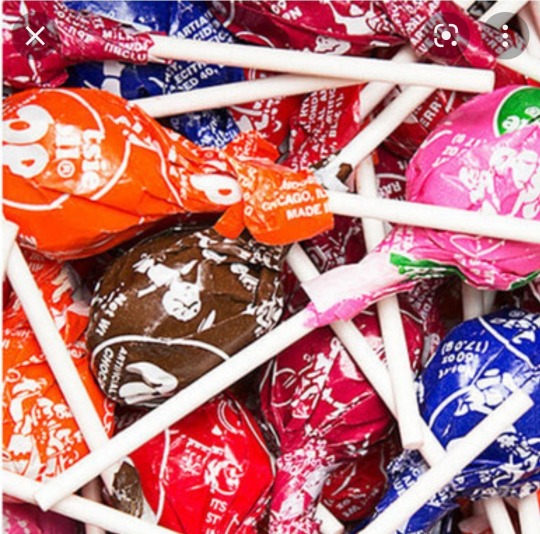
#tootsierollchallenge #tootsieroll #tootsiepop #lollipop #prelewdintimatesdotcom #prelewdintimates #lingerie2022 #Sweet #sweettooth
0 notes
Text
Ποιες οι πιθανότητες τα μαλλιά σας να περιέχουν ίχνη χρυσού
Ποιες οι πιθανότητες τα μαλλιά σας να περιέχουν ίχνη χρυσού
Ποιες οι πιθανότητες τα μαλλιά σας να περιέχουν ίχνη χρυσού
Υπάρχει πολύ μεγάλη πιθανότητα τα πλούσα μαλλιά σας, όσο περίεργο και αν μπορεί να σας ακούγεται, να περιέχουν στην πραγματικότητα ίχνη χρυσού. Και αυτό δεν είναι αστείο. Είναι αλήθεια και αποδεικνύεται επιστημονικά, σύμφωνα με το mentalfloss.com και όσα αναφέρει το grunge.com.
Ενώ, λοιπόν, το Leon Studio One αναφέρει ότι τα μαλλιά…

View On WordPress
0 notes
Link
by Kyla Cathey | The old Wild West is the stuff of legends: Gunslingers robbing banks and trains. Cowboys on long cattle drives. Gold and silver rushes. Dinosaurs, UFOs, feral camels, and giant cannibals probably don’t come to mind. But every time period has its strange stories, and the Wild West is no different. Some of those stories are...
1 note
·
View note
Text
Did "Ewe" Know...
Did “Ewe” Know…


Sheep!
A few facts from ScienceKids.com:
There are over 1 billion sheep in the world.
Sheep have a field of vision of around 300 degrees, allowing them to see behind themselves without having to turn their head.
The digestive system of sheep features four chambers which help break down what they eat.
“A 2002 Oxford study found that insomniacs who counted imaginary ewes actually took longer to nod…
View On WordPress
1 note
·
View note
Link
0 notes